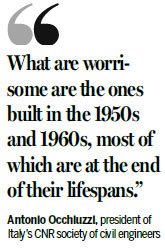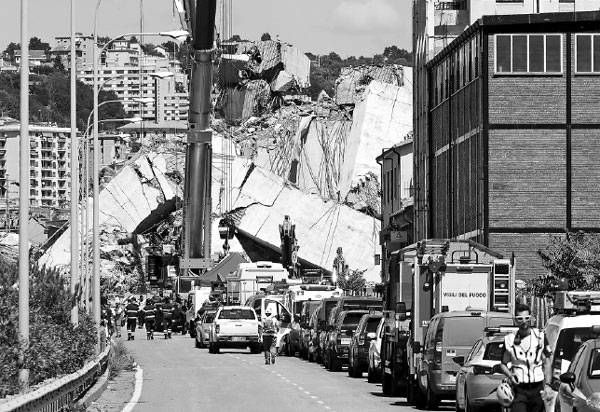Tragedy highlights aging infrastructure
Bridge collapse in Italy is spurring calls to retrofit or replace others
MILAN - Collapsed concrete, twisted metal, crushed cars.
While the disaster in Genoa was the deadliest in recent years, Italy has seen other bridge and highway collapses that have raised the alarm about the state of its aging transportation infrastructure.
|
Firefighters and rescue workers stand at the site of the collapsed Morandi Bridge in Genoa, Italy, on Wednesday. Stefano Rellandini / Reuters |
The 51-year-old Morandi Bridge was a key artery that linked highways to Milan and France, and a vital lifeline for both commercial traffic as well as vacationers bound for the mountains and famous Mediterranean beaches.
"When it was inaugurated, it was vaunted as an engineering achievement, representing the most advanced technology and a model that Italy spread throughout the world," said Antonio Occhiuzzi, president of Italy's CNR society of civil engineers.
"It was a project that was constantly under surveillance," he said. "Notwithstanding all these efforts, it came down. It is a little metaphor for the country."
Designed by Italian engineer Riccardo Morandi, its unusual features included concrete-encased stay cables, which he used in several of his bridge designs instead of the more common steel cables. Experts say the concrete can deteriorate relatively quickly.
"About the project, there were a lot of concerns since the very beginning," said Enrico Musso, a professor of transport economics at Genoa's University of Studies. "On this kind of project, only three bridges were built around the world, and the other two already had serious problems."
One built in Venezuela partially collapsed two years after its opening after being struck by a tanker, killing seven. Another built in Libya and opened in 1972 was shut down in October 2017, according to the Italian news agency ANSA.
Many technicians had advised replacing the Genoa bridge, too.
In the wake of Tuesday's collapse, prosecutors are investigating both its possible design flaws as well as maintenance, although they have not identified any targets. Some in the government blame Italy's partially privatized highway system, alleging that too much emphasis is put on profits.

The disaster, in which dozens of vehicles plunged 45 meters when part of the bridge collapsed, is spurring calls to retrofit or replace others in Italy that are operating well beyond their expected lifespan and despite technological advances.
A survey published this week by the CNR engineering group cited four other major highway overpass collapses in the last two years alone all related to structural weakness. They caused three deaths and four injuries.
The survey excluded smaller incidents that did not cause injury, but Italian media counted three more highway collapses going back to 2004 that caused four deaths and four injuries.
"What are worrisome are the ones built in the 1950s and 1960s, most of which are at the end of their lifespans," Occhiuzzi said, adding that they often are difficult to retrofit efficiently and probably cheaper to replace.
The government is focusing blame for the Morandi Bridge collapse on the Autostrade per l'Italia company operating the A10 highway that includes the bridge, citing a lack of maintenance, and is pledging to revoke Autostrade's highway concession.
Interior Minister Matteo Salvini also has blasted European Union spending rules. But the EU says that not only has it "encouraged investment in infrastructure", but also has approved $2.8 billion for Italian infrastructure, including roads, in the 2014-20 budget, and that it approved in April another $9.7 billion investment plan for Italian motorways, including the Genoa area.
Still, figures from the Organization for Economic Cooperation and Development show that Italian investment in roads sank most dramatically among the top five European economies after the 2008 economic crisis, never fully recovering.
From a level of just under $15.5 billion a year in 2007, second only to France, Italy dropped to $4.3 billion in 2014.
AP - Xinhua
(China Daily 08/18/2018 page9)















